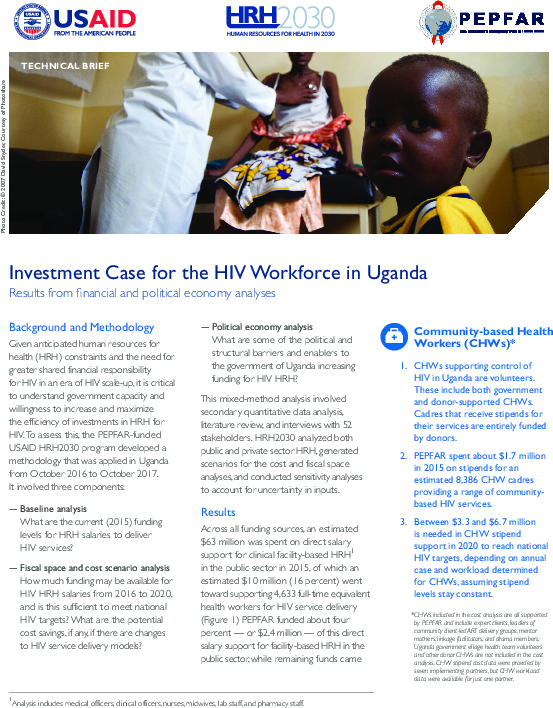
Briefs, Fact Sheets and Brochures
Technical Brief: Investment case for the HIV workforce in Uganda
Publication year:
2018
English
Format:
(754.9 KiB)
Publisher:
HRH 2030, Human Resources for Health in 2030,PEPFAR, US President's Emergency Plan for AIDS Relief,USAID, US Agency for International Development
Given anticipated human resources for health (HRH) constraints and the need for greater shared financial responsibility for HIV in an era of HIV scale-up, it is critical to understand government capacity and willingness to increase and maximize the efficiency of investments in HRH for HIV. To assess this, the PEPFAR-funded USAID HRH2030 program developed a methodology that was applied in Uganda from October 2016 to October 2017. It involved three components:
- Baseline analysis;
- Fiscal space and cost scenario analysis; and
- Political economy analysis.
The analysis from Uganda has implications for other countries. Many countries likely face funding gaps for HRH that jeopardize achievement of national and global HIV targets. In these cases, an evidence-based HIV workforce investment case can lead to a better understanding of planning requirements and convince key stakeholders to make more strategic investments in HRH for HIV. The type of strategic investment required will vary by country, but may include increased government spending, reallocation of existing financial resources, increased provision of HIV services in the private sector or at the community level, integration of HIV financing into broader health financing reforms (e.g., health insurance), and/or smarter use of HRH through introduction or expansion of efficient service delivery models, such as differentiated models of care for ART.
Read full abstract
View & Download
English
1 Documents
Document information
Publisher
Content type
Country
Region
Rights
© Author/Publisher
Found a mistake? Help us improve!
If you have noticed a document assigned to the wrong author or any other inaccuracies, let us know! Your feedback helps us keep our data accurate and useful for everyone.
Share
Link
